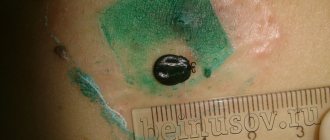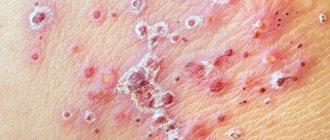Herpes
The concept of “herpes during pregnancy” is too broad and often becomes a cause for unreasonable panic among pregnant women who do not know what and in what cases there may be a threat to their unborn child. It is important for a pregnant woman to have information about all the features of this disease at different stages of pregnancy in order to contact a gynecologist in time and understand when there is really a danger to the fetus when a cold on the lips appears.
If a woman in an interesting situation has a recurrent form of the virus, that is, she had already encountered it before pregnancy, almost any manifestation of herpes is not dangerous for the mother and child. The simple herpes virus can be a threat during pregnancy only if it is a primary infection, especially in the early stages, when all the internal organs of the baby are developing and, most dangerously, the neural tube. Only in the case of primary infection in the early stages of pregnancy, up to the second trimester, does the virus pose a threat, as it can lead to frozen pregnancy, miscarriage, and developmental abnormalities. However, such a clinical situation is more likely to be an exception to the rule, because most women repeatedly experience herpes before pregnancy.
An important aspect of the body's defense system against viruses and microbes
In the process of evolution, humans have developed various defense mechanisms that allow them to resist various infections. Thus, the interferon system IFN is one of the most important factors of the body’s resistance, participating in various immunological reactions. Interferons are a group of biologically active proteins or glycoproteins synthesized by the cell in the process of a protective reaction to foreign agents, which include viral infection. Currently, the concept of “interferon system” (SI) has emerged. It does not belong to any specific organ, but exists in every cell, so all of them can be infected with a virus and must have a system for recognizing and eliminating foreign genetic information. SI is configured to recognize “self and foe” and is “built-in” into almost all cells of the body, which allows it to actively influence the entire cascade of the body’s defense reactions from phagocytosis to inflammation, which makes it an important factor in nonspecific resistance. As a result of the study of interferons, their role was determined: control and self-regulation of processes in the body. The main effects of interferon protection: antiviral, antimicrobial, immunomodulatory, preventing excessive cell proliferation, protection against radiation and others. Herpesvirus infections cause an imbalance in the interferon system, inhibit the cellular and phagocytic reactions of the body (prevent the detection, absorption and removal of viral particles). Restoration and normalization of the body’s defense mechanisms is the preventive task of antiviral therapy.
Cytomegalovirus
For a pregnant woman, the virus is dangerous if it is initially infected precisely while expecting a child. Infection from a sick person with an acute cytomegalovirus infection is the worst option for a pregnant woman, because due to the lack of antibodies in the blood, the virus easily penetrates the placenta and has a negative effect on the fetus. According to statistics, fetal infection occurs in 40-50% of cases. The degree of adverse effects of the virus on the fetus depends on the duration of pregnancy. If the fetus is infected in the early stages of pregnancy, there is a high probability of spontaneous miscarriage or abnormal development of the child. If the infection occurs at a later date, no fetal malformations are observed, but quite often polyhydramnios occurs during pregnancy, premature birth and so-called “congenital cytomegaly” of the newborn are observed. Such children may have jaundice, enlarged livers and spleens, and anemia.
Rubella
Rubella is a viral infectious disease transmitted by airborne droplets. The incubation period for rubella is from 11 to 24 days, and the sick person poses a danger to others from the 7th day after infection until the 6th day from the moment the rash appears. The disease usually has a benign clinical course, with rare complications. Symptoms are moderate and are characterized by fever, malaise, skin rashes, and possible conjunctivitis. The disease is usually accompanied by enlarged lymph nodes. After an infection, persistent immunity develops. Women who have had rubella have a high level of protection against reinfection. If reinfection occurs during pregnancy, the risk of infection of the fetus is minimal. Reinfection is more common in vaccinated people than in people who have had the disease.
Infection of rubella in a pregnant woman is fatal to the fetus. The risk of fetal infection decreases with increasing gestational age: the risk is highest if the mother is infected during the first two months of pregnancy (40-60%), then it progressively decreases during the fourth and fifth months (10-20%). Infection in the first trimester is an indication for termination of pregnancy. If rubella infection occurs in the second or third trimester of pregnancy, then, as a rule, there are no irreparable consequences for the fetus, but growth retardation and other disorders are possible. Finally, if a child is infected with rubella in the last month of pregnancy, a child may be born with manifestations of rubella, after which it progresses in the same way as in children infected after birth, and usually does not cause serious consequences.
If a woman planning a pregnancy has not previously had rubella, she needs to be vaccinated. Preventive vaccination leads to the development of immunity in 95% of recipients.
The diagnosis of rubella is made on the basis of clinical data and laboratory examination data (determination of antibodies to the rubella virus in the blood).
The body's initial immune response to infection is the synthesis of IgM antibodies, high levels of which appear in the blood 2 weeks after infection and persist for 1-2 months, IgG antibodies appear approximately a week after IgM and reach a plateau after 6-10 weeks, then progressively decrease and then persist throughout life.
The study of IgM and IgG antibodies to the rubella virus fully ensures the diagnosis of an acute disease, in addition, the determination of IgG antibodies allows us to judge the strength of immunity after vaccination. Monitoring of seroconversion after vaccination should be carried out no earlier than 8 to 10 weeks.
Eppstein-Barr virus
The Epstein-Barr virus predisposes to premature termination of pregnancy, fetal malnutrition, and in newborn children it causes damage to the nervous system, visual organs, recurrent chroniosepsis, hepatopathy and respiratory distress syndrome. However, this virus provokes the listed pathologies only under certain conditions, under which it becomes dangerous during pregnancy. It is very bad if a pregnant woman has not previously encountered the Eppstein-Barr virus, which is why she does not have antibodies to this virus in her body. If there was contact, and antibodies were detected after treatment, then this is a good sign, because in this case there is nothing to be afraid of. This serves as evidence that if a woman’s body becomes infected again, she will cope with this dangerous disease on her own. This means that a pregnant woman will not have to take medications that are heavy and quite dangerous for the development of the fetus.
conclusions
1. Standard treatment regimen with Valvir
is effective for the treatment of recurrent genital GVI.
2. During treatment with Valvir
in patients with CHRGVI, there is a reduction in the duration of local symptoms of relapse.
3. Valvir's
in the first 6 hours from the onset of exacerbation of GVI significantly improves the quality of life of patients.
4. Drug Valvir
It is well tolerated and safe in both young and older patients.
How does the virus enter the body and why is it activated?
Of the eight types of herpes viruses known today, the cause of rashes on the lower part of the face and genitals are usually HSV-1 (mainly herpes labialis) and HSV-2, which has more dangerous consequences. Transmission of HSV-2, as a rule, occurs through sexual intercourse, but vertical transmission is also possible - from mother to child during childbirth. Moreover, if a pregnant woman is infected for the first time, then the risk of neonatal herpes in the baby is 50 to 50, and in case of relapse, only 3-5% of children are born with signs of herpes infection. With the vertical mechanism of infection, the fetus is infected through maternal blood during childbirth, or the virus enters the pregnant woman’s uterine cavity from the cervix. At the same time, a high level of immunoglobulin proteins in the blood (antibodies) can protect the fetus from intrauterine infection. Cellular immunity also plays an important role in preventing the recurrence of herpes. In turn, the frequency and intensity of relapses depends on the state of local (mucosal) immunity. When there is a malfunction in the immune system, there are exacerbations of herpes infection. Injuries, surgeries, cosmetic procedures, sexual contacts that injure the mucous membrane, and taking certain medications can trigger a relapse. With reduced levels of T-cell immunity, conditions are created for the virus to multiply in cells. Interferon deficiency plays a significant role in the pathogenesis of herpes. In foci of herpetic lesions, local suppression of interferon formation is noted. VIFERON for herpes during pregnancy in the form of Suppositories can be taken starting from the 14th week, however, local forms such as Gel and Ointment have no restrictions on the duration of pregnancy. They are used directly on the affected areas: skin and mucous membranes.
Complexes with this research
IVF planning Examination for preliminary preparation of a woman for the IVF procedure 8,740 ₽ Composition
Pregnancy planning. Diagnosis of infections 14 tests for expectant mothers 5,700 ₽ Composition
Male infertility. Extended examination Analysis of male reproductive health 19,090 ₽ Composition
IN OTHER COMPLEXES
- Miscarriage RUB 28,550
- Joining IVF RUB 14,350
- Examination during pregnancy. 1st trimester 9,770 RUR
How to behave if the disease manifests itself
Speaking about household habits, it is worth noting that hand hygiene during a relapse of herpes is very important. Do not touch the affected area with your hands, because the infection can be transferred from the face to the genital area. Infection of the birth canal before childbirth may lead to a caesarean section. Herpetic infection in pregnant women requires mandatory treatment under the supervision of a specialist. If a pregnant woman is surrounded by someone with signs of infection, close contacts should be avoided: kissing, sex, and you should not share dishes, linen, or towels with the patient.
Treatment regimen:
Pregnant women from the second trimester of pregnancy (starting from the 14th week of gestation) are recommended to use the drug VIFERON® 500000 IU, 1 suppository 2 times a day every 12 hours for 10 days, then for 9 days 3 times with an interval of 3 days (on the fourth day) 1 suppository 2 times a day every 12 hours. Then every 4 weeks until delivery VIFERON® 150,000 IU, 1 suppository 2 times a day after 12 hours every day for 5 days. If necessary, before delivery (from the 38th week of gestation), the use of the drug VIFERON® 500,000 IU, 1 suppository 2 times a day after 12 hours every day for 10 days. Ointment for local and external use (interferon content 40,000 IU) is applied in a thin layer to the lesions 3-4 times a day and rubbed in gently. Duration of therapy – 5 – 7 days. You can also use Gel (interferon content 36,000 IU). A 0.5 cm strip is applied using a spatula or a cotton swab/cotton swab to a previously dried affected surface 3–5 times a day for 5–6 days; if necessary, the duration of the course is increased until the clinical manifestations disappear. It is advisable to start therapy at the first signs of relapse: tingling, redness, itching.
Effects of therapy with VIFERON
“The use of the drug VIFERON® from the 14th week of pregnancy contributed to:
– exclusion of signs of hematogenous infection;
– reducing the frequency of ascending infection by 4.5 times;
– reducing the incidence of pathology in newborns (infectious and non-infectious);
– exclusion of structural changes in the central nervous system in newborns;
– increasing the frequency of births of healthy children by 2 times [1];
According to available data: “The inclusion of the drug VIFERON® in complex therapy helps reduce:
– threats of termination of pregnancy 2 times;
– polyhydramnios and oligohydramnios by 3 times;
– gestosis by 2.5 times;
– the frequency of replicative forms of the virus is 2 times (HSV from 79.3% to 45%, CMV – from 62.2% to 33.3%);
– the frequency of relapses of concomitant bacterial vaginosis is more than 1.5 times (mycoplasma and ureaplasma);
– the total number of non-infectious complications of the perinatal period by 2.5 times (from 28.6% to 12%)
– the total number of cases of IUI in newborns increased 5 times (from 26.7% to 5.2%);
– the incidence of severe forms of IUI doubled (from 25% to 11.3%) [2].
Reference and information material
Author of the article
Belyaev Dmitry Alexandrovich
General doctor
Sources:
- Bocharova I.I., Novikova S.V., Malinovskaya V.V., Vyzhlova E.N., Parfenov V.V. Perinatal aspects of herpesvirus infections // Medical Advisor. Gynecology. 2021.1/(41).
- IN AND. Krasnopolsky, T.G. Tareeva, V.V. Malinovskaya. Monitoring of pregnant women with viral infections of the herpes family // Medical technology. – M. 2021. – 40 p.
i https://www.lvrach.ru/
ii https://medi.ru/
Loading...
Take other surveys
Herpes during pregnancy. Is it possible to resist him?
What can be advised to those who, with the help of approved medications, seek to stop herpes during pregnancy? VIFERON is an antiviral drug that can be taken by expectant mothers. One of its properties is a wide range of antiviral activity due to the presence of interferon in the drug. That is, you can start using it already at the beginning of symptoms. This can stop the disease at the very beginning, while the virus has not yet multiplied and affected healthy cells. Doctors prescribe VIFERON for herpes during pregnancy to compensate for the lack of its own interferon and enhance antiviral protection. Already from the 14th week of pregnancy, VIFERON Suppositories are allowed in a dosage of 500,000 IU. It is prescribed for primary or recurrent herpetic infection of the skin and mucous membranes, with a localized form, mild and moderate course, including the urogenital form of infection.










